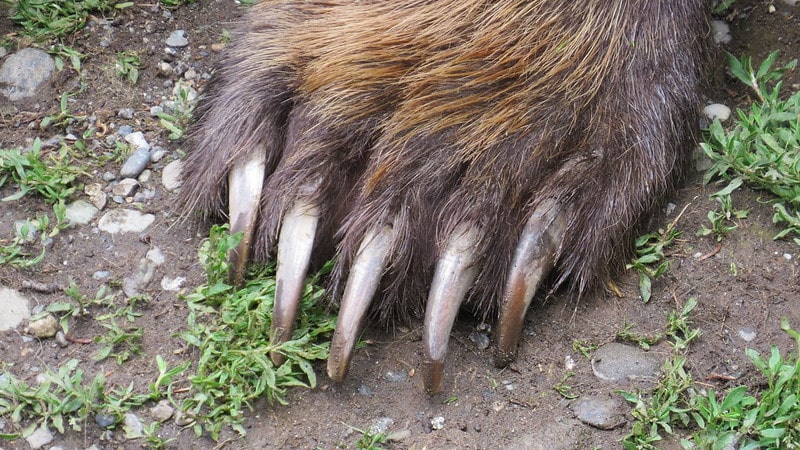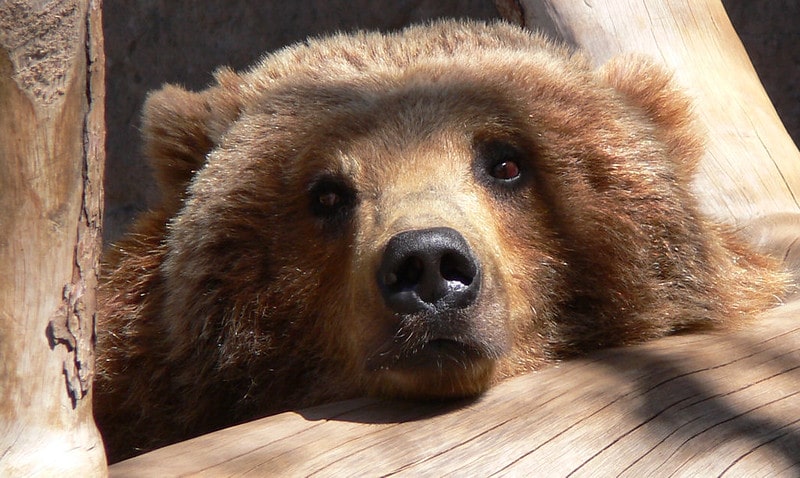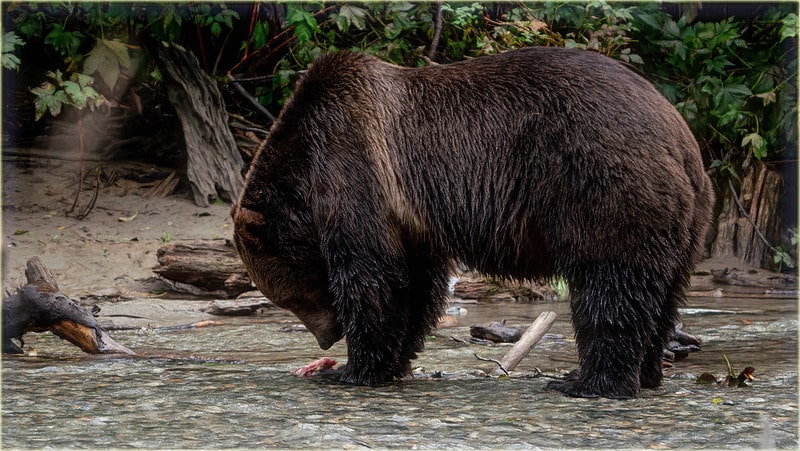Last updated on June 8th, 2023
Most of us know bears as a symbol of the warm hugs of friendship. But real bears have more to them than a warm coat. At the top of their fact sheet, grizzly bears are a subgroup of the Brown Bear, together with the Kodiak Bears. However, that’s just one of the numerous facts you can learn about bears. Did you know that an individual bear may traverse a home range as large as 1,500 square miles? With these interesting facts about grizzly bears, let us learn more about them.
1. The Name Grizzly Bear has two Possible Origins
The origin of the name grizzly bear can vary depending on who you talk to. If you talk to someone who has read the old writings of a Canadian author and explorer, Edward Umfreville, grizzly means a combination of dark and white hairs. That would mean the silver-gray tips on a bear’s brown hair.
If, instead, you go by the readers of Lewis and Clark expedition journals in The Amazing Americans, ‘Grizzly’ is a variant of ‘Grisly’, a term they used to describe “the very large, tremendous, terrible, and hard-to-kill animal.”
2. Grizzly Bears Are Not the Largest Bears
Have you read anywhere that the grizzly bear is the largest among bears? Wrong!
Although consensus is still elusive, experts agree that the Polar Bear is the largest of bears. Its closest rival is the Kodiak Bear (Brown Bear subgroup).
A size comparison between the two confirms that, although the Kodiak Bear can grow taller than the Polar Bear, the latter has a higher average weight record. Here’s a summary of those facts (referring to male bears, which are larger than females):
| Average Height | Average Weight | |
| Polar Bear | 8-8.4ft | 900-1,500lbs |
| Kodiak Bear | 7-10ft | 500-900lbs |
3. Pregnant Female Grizzly Bears Can Pause a Pregnancy
Mating among bears happens in spring and summer. Females have the liberty of multiple male partners in this season.
Once pregnant, a female can pause the pregnancy through a biological strategy known as diapause or delayed implantation. Diapause is used to wait for favorable gestation conditions, including enough fat storage for the hibernating season, which is the time when cubs are born.
If the right conditions are not created, the embryo is reabsorbed and not implanted.

4. Most Grizzly Bear Births are Twins
Grizzly bears can give birth to 1-4 cubs in a single litter. However, it is a fact that most grizzly bear births are twins. A long-term study of reproduction patterns among grizzly bears in the Denali National Park, Alaska, recorded 61% twin births. Triplet births (21%) were also more common than single births (18%).
5. Grizzly Bears are Long-living Mammals
Most wild grizzly Bears live to their late 20s, although some have recorded a lifespan of 35 years. But grizzly Bears will live longer in captivity.
The longest living Grizzly Bear was known as Brownie and lived for 56 years. The Bear would probably have lived longer. However, on 22 May 2009, Brownie was put to sleep due to severe health problems.
6. Grizzly Bears have Double Coats and Shed in Summer
In animals, double coats have the function of temperature regulation during the cold and hot seasons. This is also true in grizzly Bears.
The bears have a double coat made with a dense undercoat of shorter fur and an outer coat with longer guard furs. The outer hairs bear the silvery tips associated with its ‘grizzly’ name.
The outer coat grows in winter to preserve body heat and is shed in summer, leaving a darker coat. Winter-to-summer shedding can make the same Grizzly Bear seem completely different.
7. Grizzly Bears Can Go for 4-6 Months Without Food
Grizzly bears hibernate in winter. They enter their hibernation dens between October and December and only come out between March and May. Females enter hibernating dens earlier and leave later. Their cubs are born in hibernation, usually around January and February.
In the fall, grizzly bears increase their food intake to store fat in preparation for hibernation. The fat is a crucial energy source for the long months in hibernation.
8. The Hump is Typical of Brown Bears
The hump, a collection of shoulder muscles, is typical of grizzly bears. This muscle lump helps the animals extract force when running and using their long paws to dig, lift, or catch prey.
The hump differentiates grizzly bears from Black Bears. Other features distinguishing grizzly bears from Black Bears include a concave-shaped face and longer but semi-curved front claws.

9. Grizzly Bears Go into a Form of Hibernation called Torpor
When smaller animals hibernate, they become completely inactive and do not come out of the hibernating state until the environmental conditions are favorable.
It is naturally healthier for grizzly bears to do the same to preserve their stored energy. However, they can break their hibernation and become temporarily active. This usually happens if they sense food around. This hibernation-like winter survival tactic is known as torpor.
10. Grizzly Bears have an Extremely Slow Reproductive Rhythm
Grizzly bears have a slow reproductive rhythm, sometimes blamed for their low population growth. Female grizzly bears usually start bearing at 5-9 years. They also have an extended between-birth interval of 2-3 years. This interval can be longer when paused pregnancies get reabsorbed.
Luckily, female bears have an extended birthing age that goes into their late 20s.
11. Female Grizzly Bears are Super Committed to Their Cubs
Some animals leave their young ones to fend for themselves soon after birth or a little after. grizzly bears are great nurturers and will keep their cubs around them for up to 3 years. Even yearlings (subadults) can be seen suckling.
Also, while male grizzly bears hibernate alone in their dens, females keep the cubs with them until they are ready to mate and reproduce again.
12. Grizzly Bears can be White
Grizzly bears are widely associated with a brown coat that varies from a darker brown to a lighter tan. Although some have indicated that a grizzly Bear’s coat can be almost white, white bears are actually a reality.
Recently, a rare white Grizzly Bear was spotted in Banff, Canada, and has since been making its round in media.

13. Grizzly Bears are Foodies
Grizzly bears are generalist omnivores. Although their main diet consists of plants and insects, they can go for larger animals for food. A grizzly bear eating behavior survey in the Greater Yellowstone Ecosystem found that these animals fed from over 266 food sources, including:
- Plants
- Animals (mammals, invertebrates, amphibians, fishes, and birds)
- Fungi and algae
- Soil
14. Grizzly Bears use Scent Communication to Mark their Territory
If you spot a grizzly bear rubbing its back on a tree bark, you may think it is scratching its back. But these animals have an advanced sense of smell, which is why they use scent communication to warn others off their territory.
Grizzly bears also use urine to mark their territory or use their anal and feet glands to leave their scent on their tracks.
15. The Grizzly Bear is California’s State Animal
The Grizzly Bear has been featured on the California flag since the post-independence era. The bear flag was the fruit of a rebellion, way back in 1846. But the grizzly bear has continued to feature in all the versions of the California flag and takes the central place in the current version as the state animal.
Unfortunately, the strain of the grizzly bear on the California flag became extinct around the 1920s.
16. Excellent runners
Despite their mammoth proportions and lumbering gait, grizzly bears are excellent runners and can dash up to 35 miles per hour. They are mostly proficient as short-distance runners, covering more than 45 meters in 3 seconds! Now you know why you should never try to run away from a grizzly if you ever happen to come across one during one of your hiking expeditions!
17. A myth — they are territorial
In this connection, we ought to mention that although grizzly bears are solitary creatures, they are not territorial animals and grizzlies will often have overlapping home ranges with several other bears sharing a common habitat.

18. They are a subspecies. And you can call a grizzly a brown bear, but not the other way around.
Grizzly bears are a subspecies of the North American Brown Bear (Ursus Arctos). In coastal Alaska and Canada, they are called brown bears, and in interior areas like Yellowstone, they are generally called grizzly bears.
Grizzly bears are extremely adaptable species and can live in many different habitats. From lower wetlands and coastal areas, to avalanche chutes, to upper elevation slopes, these smart and intelligent creatures can adapt to pretty much any habitat. They also used to exist in desert wildernesses of Mexico and California, although unfortunately enough, those desert grizzlies have already become extinct.
19. Their population
At present, the number of grizzly bears are estimated to be around 55,000 and of these, as many as 50,000 are found in Alaska and the Canadian territories.
20. How many are left in the lower 48 states?
The grizzly population in the lower 48 United States, on the other hand, has decreased significantly in the last two centuries. Today, only about 1,500 grizzly bears are found in the lower 48 states, a majority of them in the Wild West of Montana and Wyoming.
21. Three other living species of Grizzly bears
Apart from the mainland grizzlies (U. horribilis), also known as the North American Brown Bear or inland grizzlies, there are three other living species of Grizzly bears. These are known as Peninsular Grizzly (found in coastal areas of southern Alaska), Kodiak Bear (also known as Alaskan Brown Bear and are found in the Kodiak Archipelago in southwest Alaska) and Kamchatka Bear (native to far eastern regions of Russia)
22. For an unknown reason
Grizzly bears living near coastal areas tend to be bigger than inland grizzlies, although the exact reason for this is unknown.

23. Their ancestors
The ancestors of grizzly bears came to North America from Asia by crossing the Beringia or the Bering Land Bridge tens of thousands of years ago.
24. They were in majority
Up to 100,000 Grizzly bears existed in areas belonging to today’s lower 48 states when the first Europeans arrived here. And their ranges were far more widespread than now, reaching up to Michigan in the east and to Mexico in the south.
25. An extinct species
Occasional and rare incidents of fatal grizzly bear attacks on humans always make big news, in North America and elsewhere. However, humans have done (and are still doing) disproportionately greater harm to these creatures. The Mexican grizzly bear, for instance, has already become extinct, along with two other species of grizzly bear, namely California grizzly and Ungava-Labarador grizzly (that used to inhabit the forests of Labrador and northern Quebec in Canada).
26. Why?
In Mexico, the burgeoning industry of cattle farming during early 20th century is cited as the principal reason behind the extinction of the grizzly bears. By 1960, there were only 30 of these large mammals left in the Mexican wild. Sadly, however, no conservation initiatives were taken, meaning the creatures became totally extinct already by 1964!
27. The tale continues
An even sadder fate befell the Californian grizzlies that had become extinct in 1924, this despite the fact that during the 1500s, the region was home to more than 10,000 grizzlies.

28. A cruel sport
California and grizzly bears actually share a rather curious (some may choose to call “gruesome!”) history. The brutal Bull-and-Bear fights originated in the 19th century California and the bloodsport used to be one of the more popular entertainments for the Californians of that time!
In fact, the basic stock market terms of “bull” and “bear” have their origins in this sport.
29. A Mission to Aid their Survival
One such laudable mission involves the plan to “plant” more grizzlies inside the North Cascades Ecosystem (NCE) in the Washington State. A 2016 Skagit environmental report maintains that NCE, with its 2.5 million acres of federally designated wilderness, has the resources and the space to support about 280 grizzly bears.
However, the grizzly population of the state at present numbers to fewer than 10, which has earned them the status of ‘most-at-risk’ grizzly bears in North America! The extent of the damage can be gauged by the fact that by early 1800s, NCE was home to thousands of grizzly bears.
30. Why grizzly bears exist?
In this connection, we ought to mention the important ecological role the grizzly bears play in a forest ecosystem as nutrient providers and seed dispersers. While foraging for food, grizzlies will also stir up the soil, thus increasing nitrogen availability and facilitating species richness.
Also, as keystone predators, the decline in population of grizzlies in an ecosystem will directly affect the food chain equation and the subsequent balance of the ecosystem. For instance, a study conducted at Grand Teton National Park that involved removal of grizzlies and wolves from a certain place showed that this immediately resulted in an overpopulation of ungulates. This caused a sharp decline in the density of shrubs and plants in the area, which in its turn led to a decrease in the number of migratory birds visiting the park.

31. What they eat?
However, we ought to mention here that although grizzlies, and bears in general, are often listed as large predators, actually less than 20% of a grizzly bear’s diet consists of meat. The creatures mainly feed on nuts and berries, insects, roots, grasses, bulbs, fungi, tubers, etc.
. . . continue reading on the next page
